|
PROLOG
It
is Saturday morning and the media has stopped calling. I have my
reference material piled on tables and the ironing board which I am
putting away. I am catching up with all the news about Confederate
monuments and symbols and flags.
The publisher of Black Commentator,
a publication which has been very helpful over the years aiding my
efforts to fight the neo-Confederate movement has asked me to write a
commentary on my reaction to what is the new reality regarding
the neo-Confederacy from the perspective of a long term campaigner against
the neo-Confederate movement.
I
am overwhelmed with the recent changes, and I am sorting out in my mind
what is the new reality. First, I think I should give a explanation of
how I got into this research and the long campaign so far. It will
provide the framework for my perceptions of the new reality.
It was about twenty-three years ago while living in Dallas, Texas I saw the movie Glory
and decided it was wrong for the city of Dallas to have monuments to
honor the Confederacy and its leaders. At the same time the Soviet
Union had fallen and statues in the former Soviet states were coming
down. Through a federal court order, Dallas stopped having an
at-large system of city council representation and went to an a
district system. As a result, the city council of Dallas now had a number of minority
members.
I
thought surely with that many minority members on the city council and
a park board with a great many minority members this would be an easy
task and the Robert E. Lee statue would be removed and the Robert E.
Lee Park would be renamed. I was so wrong, I was clobbered. City
council member Domingo Garcia who put my proposal before the park board
abandoned me and African Americans on the park board were very willing
to argue against my proposal, and for the statue, and one even posed with
the Dallas Southern Memorial Association for photos. The Dallas NAACP
spoke against my effort. The Dallas Morning News was entirely against my effort.
I
got a lot of hate mail and I had to change my landline phone number to
stop getting hateful phone calls. I was surrounded by hostility not
just from neo-Confederates and white people, but the city’s minority
leadership. When I spoke at a public hearing on the issue the park
board minority members staged a walk out. I was alone and it was scary.
Last Thursday and Friday I read that the Dallas Morning News editorialized that the Confederate statues need to go. They
interviewed me in a story and I am now a sort of pioneer. It still is
hard to believe, though I have read the article three times and will enjoy reading it again.
After
being defeated, I went down to the downtown Dallas Public Library.
During my campaign I had seen in the card catalog a magazine called the Southern Partisan and it was in the back room. I asked to have all the issues brought out to me to browse through.
The
contents were astounding. It wasn’t just the racism, it was seeing who
was involved in this publication. It was professors, authors,
columnists, elected officials, and prominent conservatives. It wasn’t
something poorly produced by marginal individuals on the fringes, it
was a magazine produced by highly educated people who were in the
system and able to exert influence in multiple venues.
It
wasn’t just a magazine focused on defending the Confederacy, it was
also developing a reactionary ideology for the readership, a world view
of society, religions, history, politics from a Confederate point of
view.
I
thought at the time that people would be astounded that prominent
individuals were involved in this movement, and also surely this showed
the “heritage” was hateful in response to the Sons of Confederate
Veterans slogan “Heritage not Hate.” However, it turned out that a lot
of people really didn’t want to know about the neo-Confederate
movement. I discovered that the Confederacy had a lot of friends across
the political spectrum. I remember one individual who was a member of
a self-proclaimed radical group saying, “I am not like my mother who is
a member of the United Daughters of the Confederacy, but I think you
are slandering the South.”
People
expect a racist to be a marginal individual, rude, belligerent,
spouting racial slurs and can comfort themselves that they must not be
racist since they are not like that. I was discomforting. Newspapers,
major dailies, liberal magazines and other publications were resolutely
not interested.
So
I continued to research year after year, purchasing all the
neo-Confederate magazines and back issues, indexing them, archiving
them, and purchasing all the neo-Confederate books, videos, audio
cassette tapes and indexing and archiving them. I would try to get
news media interested but largely failed. There was just a few
articles here and there in the alternative media
However,
starting in 1998 matters started to change. Trent Lott was heading up
the impeachment effort against Bill Clinton and by
getting on the Internet, I started to get emails about the impeachment
and ignored them for a couple days until someone pointed out that the
topic of the Council of Conservative Citizens (CofCC) had come up and
Lott was denying he was a real supporter. Using the Internet, I got Tom
Edsall’s phone number and called and the next day I was faxing. All the
material you read on the internet about Lott’s involvement with the
CofCC or his interview in the Southern Partisan came from material I supplied to journalists at one time or another.
After
a few years no elected official or anyone who wanted a career in
government or politics would speak to the CofCC or be a member.
Then in 2000 John McCain had hired Richard Quinn, a political consultant, who also was also the editor of the Southern Partisan. All of a sudden the Southern Partisan
was big news, a national scandal. Interestingly enough, George W. Bush
won the South Carolina primary with a campaign run by Richard T. Hines,
former associate editor of the Southern Partisan.
The Southern Partisan
afterward started to lose article contributors and couldn’t get anyone
to interview who wasn’t retired or had an expectation of a career. It
gradually sputtered out and the last print issue was in 2008. I had
defeated a major institution that was developing the neo-Confederate
movement and a major means of their connection into the Republican
Party.
However,
in 2000 that fact that Dick Armey, Phil Gramm, Thad Cochrane, Lindsey
Graham, Jesse Helms, and other prominent conservatives, Jerry Falwell,
Pat Robertson had interviewed in the Southern Partisan was not considered news by reporters as much as I tried to get journalists interested.
Each
time, as suddenly as neo-Confederacy was in the news it was then not
news. I realized that my material was news when one political group
wanted to get at another political group. However, this led to some
victories and at least some awareness of the neo-Confederate movement.
The
most important thing around that time was contacting Euan Hague,
originally from Scotland, a then university teaching assistant, now a
professor at DePaul University in Chicago, who needed some material to
support a claim he had made on the British Broadcasting Corporation
radio. I had the material.
The
neo-Confederates have a theory that the South is Celtic and has
distinctive racial characteristics in contrast to non-Southerners who
are held to be English and having different racial characteristics.
Scots don’t like Scotland being the object of racist fantasies. Euan
convinced me to write an article for Scottish Affairs
at the University of Edinburgh. I am a chemical engineer in
semiconductor manufacturing. When I was in college the English
professor offered me a deal to rewrite all my papers and he would give
me a C grade. I accepted the professor’s offer immediately without
discussion. An academic paper seemed daunting but I decided to do it.
After a lot of struggle I produced the paper. When it was done, I felt
that even if it wasn’t published, I was very happy to have written it.
It was published and I felt I could write another paper and it might be
published.
Then
Euan and I started writing papers together. He suggested books for me
to read and I read them and some of the books in the footnotes of the
joint papers we wrote I would buy and read. It was like getting a
graduate education in cultural geography which involves nationalism. Suddenly, for the first time I really comprehended the materials I was collecting.
After
some articles a group of us wrote the book, “Confederacy: A Critical
Introduction,” University of Texas Press, and later with James Loewen
we produced “The Confederate and Neo-Confederate Reader,” University
Press of Mississippi, which was primary documentation showing that the
Confederacy was about slavery and white supremacy and that after the
Civil War honoring the Confederacy, neo-Confederacy, was about white
supremacy. James Loewen tried to get this book an award by the Museum
of the Confederacy. I averted this by writing the Museum of the
Confederacy that I would publically reject the award and write an
expose of them.
I
am happy to report the book didn’t get the award. I was condemned
strongly by some Civil War historians. Which brings up another issue,
white supremacy and neo-Confederacy tends to be given a free pass in
the fields of Civil War history and Southern Studies.

So
by now I had become a subject matter expert, surely I would get a
hearing for my research during controversies over Confederate symbols
and surely my research on the neo-Confederate movement would get a
public airing. No such luck. I couldn’t even get the entry in Wikipedia
for Neo-Confederate properly edited. Neo-Confederates would undo my
edits and the Wikipedia editor in this case was indifferent. Wikipedia
is a playground for neo-Confederates, but as one person I don’t have
the time to engage in futile efforts.
It
wasn’t all bleak during this period of time. I did get some information
to the public here and there. People were purchasing the two books and
once people understood what neo-Confederacy was they could recognize it
when they hear or read it. I did finally get Bill Clinton’s three
letters of congratulations to the United Daughters of the Confederacy
published online by BlackCommentator.com.
I
did provide a wealth of materials to academics whose writings helped
bring before audiences information that related to neo-Confederates.
“Loathing Lincoln” by John Barr is one example.
However,
I felt very strongly that I was really failing. I had multiple
potential academic projects that I could do, and as such I might have a
very successful academic career, my goal, which is to defeat
neo-Confederacy, was failing badly.
The
United Daughters of the Confederacy and the Sons of Confederate
Veterans were still able to present themselves as sentimental heritage
advocates instead of being known for who they were. The neo-Confederate
movement and its agenda was still largely unknown to the general
public. There was no movement to get rid of a racialized white
landscape of statues and symbols. Elected
officials still wrote letters of congratulations when the UDC and SCV
had conventions in their town. Churches still offered their facilities
to them.
Also,
I was discovering that I was getting old, the surprise when you
suddenly realize that it is you and not just those other old people who
need the flu shot or when a senior discount comes up on your bill.
Time was running out.
So
in 2012 I sat down and started to think what I could do. One day I sat
started writing down things that people in general cared about and
thought how my research connected to these things. Basic things such
as, food, children, education, mortgages, housing, clothing, etc. I
came up with a list and then did brainstorming and screening of ideas
with some friends and came up with a candidate list of topics and set
to writing.
I needed an outlet and Black Commentator
came to my aid again. The first was an article advocating screening out
people who are sympathetic to the Confederacy from juries. In the South
this would have a tremendous impact on the composition of juries in the
South. Even outside the South it would have significant impact. Though
I have contacted many groups, no one is engaged with the idea.
Then I wrote a piece on the racism and extremism of the Sons of Confederate Veterans for Black Commentator.
This
led up to a 2013 project. Though an affinity purchasing group, We Care,
major corporations were donating money to the Sons of Confederate
Veterans. ESPN, Banana Republic, Aeropostale, Barney’s New York, DNKY,
Sakes Firth Avenue, Ralph Lauren and numerous others, were donating
money to the Sons of Confederate Veterans, it seems unwittingly. I
wrote them letters including printouts of the We Care web pages showing
their logo with the Sons of Confederate Veterans Confederate flag logo,
and a copy of the Black Commentator article on the Sons of Confederate Veterans.
It
was a quick victory. As a result of the BC report and my follow
up letters it took only eight days before BC was able to report We Care
dropped the Sons of
Confederate Veterans. It was also a sort of defeat. Besides a small
group of people in the 25 corporations I initially wrote, no one else
really knew anything about the racist and extremist agenda of the Sons
of Confederate Veterans. But it was a victory.
So
the next and current project is to write churches to not host events
for neo-Confederate groups. There have been some successes, St. Paul’s
Episcopal Church in Richmond, Virginia disinvited the United Daughters
of the Confederacy in 2014. However, otherwise I can say it was easier
to get the temples of Mammon to give up neo-Confederacy
than the churches of Christ. Evasions, or no responses and the hosting
of neo-Confederate groups has so far been the result.
Pictures of the Roman Catholic Cathedral of the Immaculate Conception
Mobile, Alabama
Note: the church office has informed BC at this time (07/02/2015) they do not display any flags in the church or at services
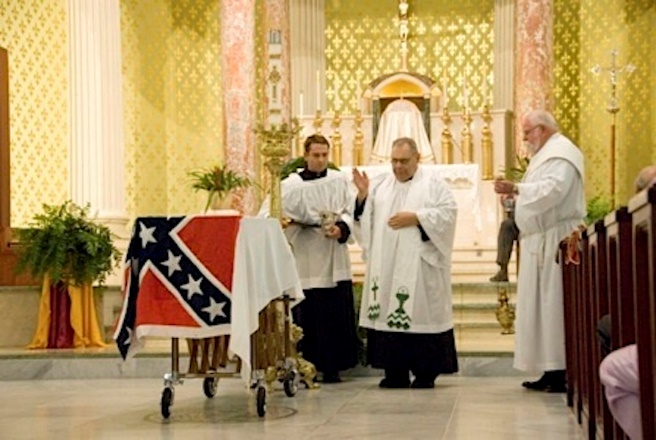
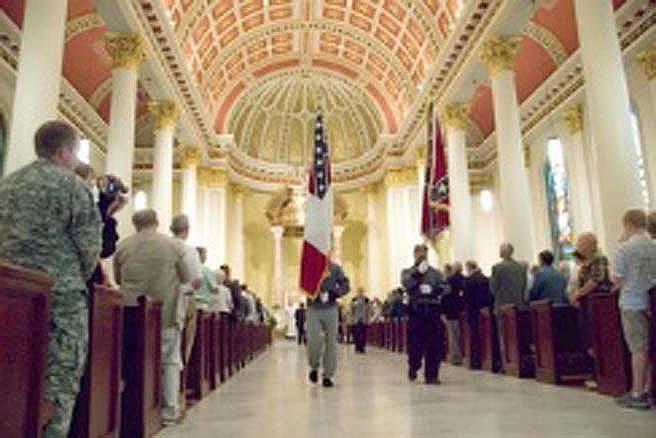
These
are not fringe denominations. The Episcopal Church, Roman Catholic
Church, the United Methodist Church and the Presbyterian USA Church are
doing most of the hosting, though it seems that the Southern Baptist
Church (SBC) is now starting to host more since it seems that some
denominations are becoming more reluctant to do so and quietly are
rejecting neo-Confederate groups.
I wrote the president of the SBC, their entire executive board, the
leadership of the Ashley River Baptist church, where a recent
neo-Confederate event occurred, and there was no response. Also I have
written Russell Moore, President of the Southern Baptist Ethics &
Religious Liberty Commission who was interviewed in the media about the
SBC reaching out to minorities. No response. The Court Street UMC
in Lynchburg, Virginia is scheduled to host the Children of the
Confederacy, a youth group run by the United Daughters of the
Confederacy to indoctrinate young people that the Confederacy was
glorious, on July 16, 2015. I have written Rev. Dr. Mark A. Tinsley, no
response.

It has been an uphill battle getting anywhere with the Churches but I
keep working at it. I have realize that it isn’t just an activist
project, I am mapping out American Christianity and race.
I am also planning to start writing letters to the American military
regarding the Sons of Confederate Veterans’ attempt to get themselves
involved in high schools by giving awards to Junior ROTC cadets
evidently with the U.S. military’s approval.
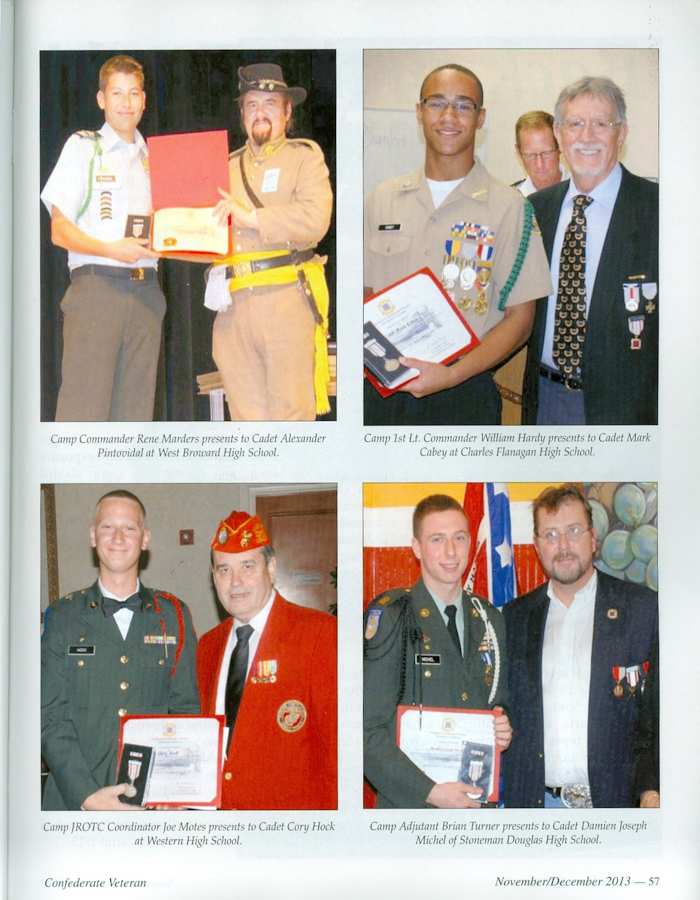
Finally I have decided to leave the desk and get out there and meet
people, to speak and to protest. Another article isn’t going to defeat
neo-Confederacy by itself.
I have a PowerPoint presentation about the neo-Confederate movement
which I have started to give to show that the core idea of
neo-Confederacy is inequality and how that relates to everyday life.
Since May of this year I have been
planning protests at the 2015 Sons of Confederate Veterans National
Reunion and will be protesting at their reception at the Museum of the
Confederacy in Richmond, Virginia on July 15, 2015 from 5pm to 9pm. This is
the Facebook Event Page.
THE NEW REALITY
Then the Charleston Church Massacre occurred. I recognized from
the jacket patches that the person was likely a neo-Confederate and as
news came out I was busy researching and downloading, and printing
information from Dylann Roof’s Facebook page and his website before it
disappeared from the web and then came the journalist inquiries.
There have been astounding changes. For example, the National Cathedral
announced that they were going to get the Confederate stain glasses
removed. They were donated by the United Daughters of the Confederacy.
This was a goal I wasn’t even going to try until sometime in the
distant future. I would be quite content to just get the
Episcopal Church to stop hosting neo-Confederates and it seemed even
that would take years.
Monuments and flags and Confederate symbols are rejected by government
and commerce everywhere. There is a call for the Jefferson Davis
highway to be rejected in Arizona, though for some reason California
and New Mexico are keeping it. It is like a revolution. [It goes from
Alexandria, Virginia to San Diego and up to the northern border of
California.]
The recent surge against the Confederacy is good, it will have to be
seen how many monuments and flags come down. But surely some will go.
And the more the Confederacy is removed from daily life the less it
will be normalized and the more the remaining instances of the
Confederacy will seem anomalous which will help to get some of them
removed and the cycle repeats. This is important. Every Confederate
monument whispers, “civil rights is just the slogan of the day but
white supremacy is for the ages,” the monument’s whisper is the truth,
for if the nation really believed in civil rights, why is the monument
still there?
The neo-Confederate movement is enabled by these public endorsements of
the Confederacy by symbols and monuments which normalize the
Confederacy. The fewer there are, the more the neo-Confederates will not
be accepted.
One unfortunate feature of the new opposition to Confederate flags is
that it is still often framed in the paternalistic terms of it being
offensive to African Americans which reduces the argument to African
American emotional reactions, not that African Americans might have an
intellectual assessment that the racialized landscape and endorsement
of the Confederacy by government bodies is a denigration of their
humanity and inimical to their rights. I think some people sense this
and it might be why they think the effort is a distraction.
Worse is that this argument doesn’t acknowledge that the Confederate
landscape and the Confederate symbols primarily serve to poison the
thinking of white people.
A friend joyfully proclaimed that I could “retire.” Is the struggle over or nearly over? Not at all.
The flags and monuments may come down but the neo-Confederate movement
is still there. They are still generally not known to the public and
they are still having an enormous impact. For example, the Politically
Incorrect Guide to American History is a New York Times best seller, it
is written by Thomas Woods, a leading neo-Confederate. The
American conservative movement is learning its American history from a
neo-Confederate. Many of the other books in this series are also
written by those who contributed to Southern Partisan. The
neo-Confederates have a lot of soft power through various means like
these books and through other avenues. There still is the Abbeville
Institute made of professors and university students. I struggle to get
the public to understand that these people are educated and not like
Klansmen. They are in the system, in the establishment. There is still
almost no public awareness of this movement. Though this is
beginning to change some, Rich Lowry, editor of National Review,
denounced the anti-Lincoln neo-Confederate propaganda warning that:
Operationally, they are pro-Confederacy. Their influence shouldn't be
exaggerated. The vast majority of people will never hear of them. They
exist only as a small but foul temptation on the right. If American
conservatism ever wants to commit suicide, they offer the ready means.
And it begins with the root-and-branch rejection of Abraham Lincoln.
Rich Lowry hopes that they are small, but neo-Confederacy is creeping into the American conservative movement.
More ominous is the percentages of people who believe that the Civil
War was about states’ rights and not slavery. The percentage that think
it is about states’ rights and not slavery goes up with decreasing age.
As the Pew Research Center reported.
Young people are more likely than older Americans to say that the war’s
main cause was states’ rights – 60% of those younger than 30 express
this view, the highest percentage of any age group. Those 65 and older
are the only age group in which more say that slavery, rather than
states’ rights, was the main cause of the Civil War (by 50% to 34%).
While 48% of whites view states’ rights was the war’s main cause, so
too do 39% of African Americans.
Note, even 39% of African Americans.
The nation is facing an imminent catastrophe where the neo-Confederate
view of the Civil War is the norm. We are about to be a Lost Cause
nation. The abolitionist view of the Civil War is about to be Gone With
The Wind.
[Lost Cause is another term for the neo-Confederate understanding of slavery, the Confederacy, Civil War, and Reconstruction.]
The reader might ask how can this be with so much opposition to the
Confederate flag, it should be considered that much of the opposition
is framed with the paternalistic idea that the Confederate flag is
emotionally hurtful to African Americans through misuse by the Klan or
associations with slavery.
This shouldn’t be surprising if a person looks at American school
history textbooks of which the author has bought many. The
neo-Confederates raise a stink about text books and the result is text
books that leave the question of the cause of the Civil War unclear.
James Loewen as part of the research for the book, “The Confederate and
Neo-Confederate Reader,” at his speaking engagements had the audience
vote as to the cause of the civil war. States’ rights won each time,
even with a group of African American school teachers. If we teach a
history that black lives don’t matter is it surprising that often times
black lives don’t matter? It is surprising that we are becoming a Lost
Cause nation?
Then there is a developing counter revolution which seeks to block
efforts to eliminate Confederate symbols, flags and monuments from
public places. As the public’s interest wears off and the
neo-Confederates get their campaign mobilized there will be resistance.
The good thing is that so much is happening in so many places it will
be hard for them to offer effective resistance everywhere the
glorification of the Confederacy is being challenged.
However, there is one very positive development which holds a lot of
promise to defeating neo-Confederacy. Dr. David Hayes-Bautista has
researched the history of Cinco de Mayo and is the author of Cinco de
Mayo: An American Holiday. It turns out it was started in California
during the Civil War. At one Cinco de Mayo during the Civil War,
pictures of Benito Juarez and Abraham Lincoln were carried at the head
of the procession. It is an American anti-Confederate holiday and at a
2012 Cinco de Mayo celebration at the La Plaza de Arte y Cultura in Los
Angeles there was a whole evening of plays and dancing to explain the
anti-Confederate origins of Cinco de Mayo.
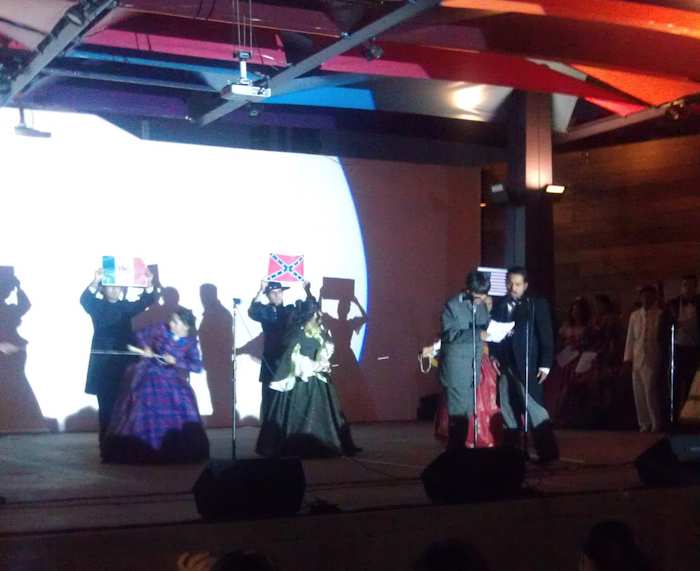
Additionally La Plaza de Arte y Cultura had an exhibition giving the
history of the Civil War and the history of the French invasion of
Mexico.
The neo-Confederates are very expressive in their hostility to
Hispanics and Hispanics have noticed. As this new understanding of
Cinco de Mayo spreads across the nation I think that Hispanics will be
less likely to tolerate the Confederacy.
I am not so worried about conservative efforts and neo-Confederates for
which I have counter measures but I am worried about the counter
measures of certain people in the Democratic Party and in some
Liberals. Arguments which will shut me down in my attempts to
get the message out to the public.
A good example is a July 26, 2015 editorial by Mary Frances Berry,
former chairwoman of the U.S. Commission on Civil Rights,” and
Geraldine R. Segal Professor of American Social Thought at the
University of Pennsylvania, in the Washington Post titled “The
Confederate flag is just a distraction.”
Berry denigrates efforts to get rid of the Confederate flag in her editorial.
Their actions are merely diversions. They are addressing the least
important cause of Roof’s racist murder spree. Focusing on flags and
monuments draws our attention from the hard work that is required to
reduce the burden of racism in American society.
And
The #TakeItDown movement is dizzyingly seductive and grows in
ever-increasing intensity, blotting out all other concerns about the
Charleston shootings.
And she makes other similar assertions that efforts to get rid of
Confederate symbols somehow preclude actions on other issues of race.
Nobody is saying that they are working to take it down in lieu of doing
something else. She seems to lack understanding of the power of
historical memory which historians and other academics are realizing is
a real form of power in society.
Berry’s arguments are nearly the same as those of Walter Williams, an
African American conservative, expresses in a Southern Partisan column
titled “Misplaced Priorities,” who opens his defense of the Confederacy
with attack on the NAACP’s opposition to the Confederate flag with this
snide remark:
Now that the schools that black youngsters attend are educating well,
the devastating crime rate in black communities has abated and the
black family has recovered its past stability, the NAACP can focus on
perceived indignities such as the Confederate battle flag flying over
the Capitol Dome of South Carolina. [Williams, Walter, “Misplaced
Priorities,” Southern Partisan, Vol. 19 4th Qtr. 1999, page 51.]
Also her views are similar to those of the Sons of Confederate
Veterans. The following is a cartoon from the Confederate Veteran, Vol.
3 2000. It shows the paternalistic racism of the Sons of
Confederate Veterans that African Americans can’t have a voice on the
issues of history and historical memory.
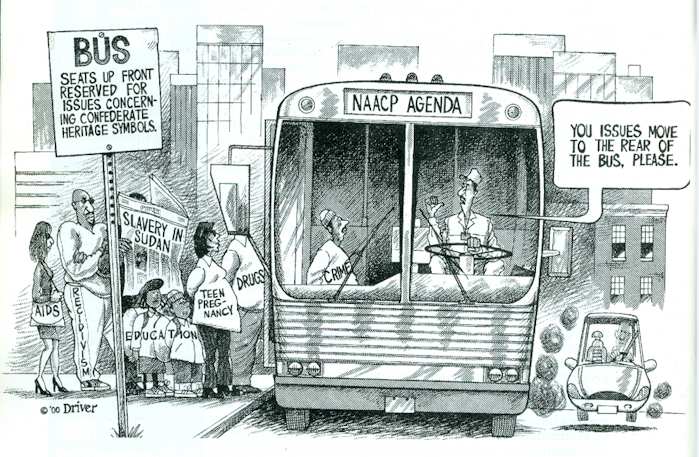
One of my challenges has been to show that the soft power of the
neo-Confederates has real impact. What is the impact when a region
believes that the Confederacy is worth honoring?
People are now plotting politics, issues and conditions geographically
across the United States. In map after map you see “Confederacies.”
The following map is the congressional vote on the 19th Amendment,
two-thirds approval was needed, it only passed by a few percent. It is
not a wonder that the United States was the 27th nation to give women
the vote.
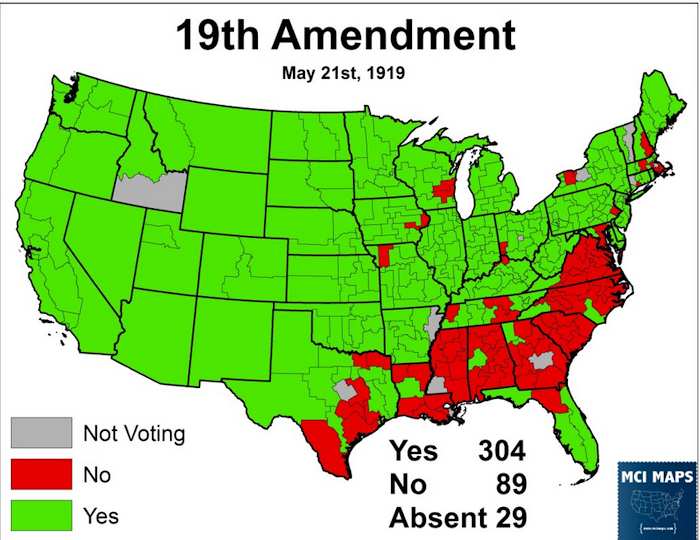
Here is another Confederacy. Phyllis Schlafly was interviewed by
the Southern Partisan after her victory party and the following is here
quote.

Or another Confederacy.
(States that ratified it are in blue.)

Or this Confederacy
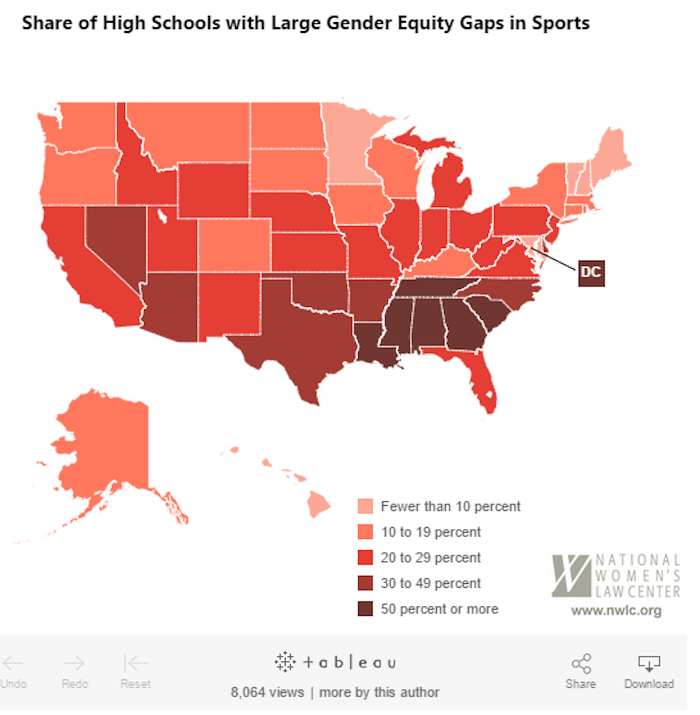
The whole point of monuments and symbols is to shape peoples identities
of who they are and incalculate certain sets of values. It seems
to work.
The point of historical narratives are to shape values and
understanding. The Bible contains narratives of what happened in the
past and all religions have narratives of what happened in the past. On
Easter Sunday the Resurrection isn’t old stuff or a distraction from
the issues of the day, but a renewal of values. So are the observances
of other religions.
The power of the neo-Confederate movement is through the shaping of
identity and values, they don’t need to advocate many specific
policies, thought they do advocate some. Once Jefferson Davis is your
hero and the plantation is your ideal, whether conscious or not, you
will naturally support the politics of inequality. Perhaps if
people don’t identify with the Confederacy they will identify with
social justice more.
When I explain to people that the core idea of the neo-Confederate
movement is inequality people tell me that there is already growing
inequality. Well yes, there is, look at this T-shirt which was sold by
the Southern Partisan and figure it out.
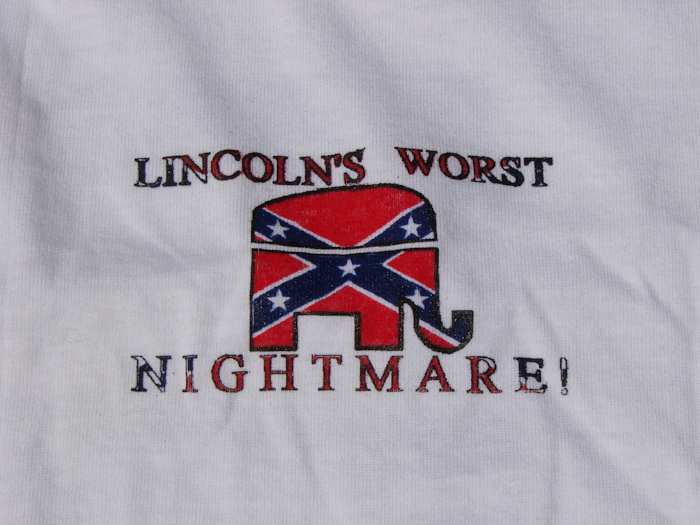
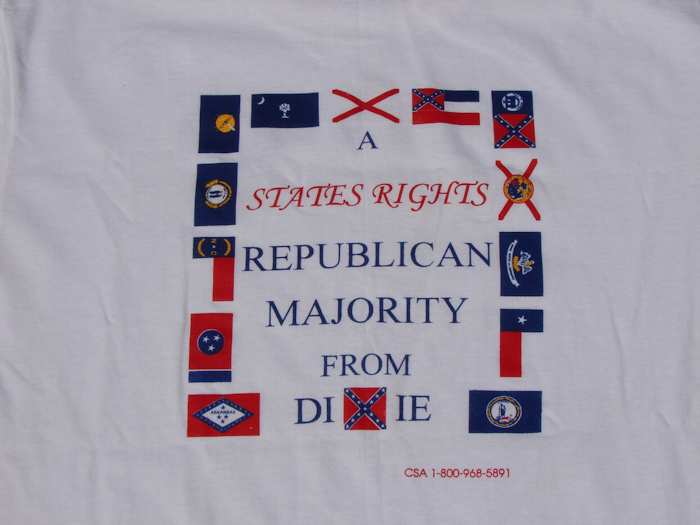
Also, it isn’t only about racism. Neo-Confederates have anger against
Liberals, Unitarians, Jews, Hispanics, Lesbians, Gays, Muslims and many
others. They are against democracy itself.
Further, Neo-Confederates believe in a hierarchical society and seek to
divide people by race, offering racial privilege to those who are
white. The many prejudices of the neo-Confederates are just a tool box
to divide people, to break down the 99% into many small
percentages.
Fighting neo-Confederacy quickly involves confronting white anger and
establishments that don’t want to confront the issues. Neo-Confederates
are not marginal fringe individuals that you will never meet, but
people in your social circles, people you will have to face, people
with influence.
Fighting neo-Confederacy can involve losing white votes, and evidently
even a few African American votes, that might otherwise accrue to a
candidate.
The arguments that it isn’t important provides cover for those who
don’t want to have to confront neo-Confederacy or politicians who hope
to poll a few extra white votes. They can pose the idea of it being a
distraction and as having a more advanced thinking. It even provides
cover for those who are sympathetic to the Confederacy, they can take
this stance to block efforts against the Confederacy by using this
argument.
The primary obstacle I face in the future and have faced in the past
isn’t the neo-Confederates, instead it is the argument that the issue
isn’t important, which shuts down the effort to fight the neo-Confederacy
and is even used by neo-Confederates to do so.
In conclusion, though recent events are very encouraging and will
represent real progress in fighting the neo-Confederacy, there is a long
struggle ahead and a lot will depend on people realizing this is
important and affects the real issues of the day.
Over the twenty three years it sometimes has seemed like I have
wandered in the wilderness. But I always remember the atrocities at
Olustee, Poison Spring, and Fort Pillow, the struggles of the
abolitionists, the suffering of the slaves, the troubling stories in
Litwack’s book “Trouble in Mind,” and go on. I have a historical
consciousness which forms my values also.
Regardless of the challenges I will be fighting to the end. With recent events I am hopeful.
|

